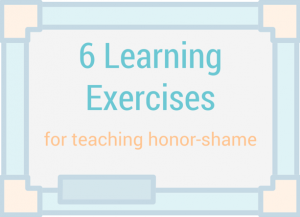6 Teaching/Learning Exercises
Before our family moved to Muslim Central Asia, I rigorously studied Islam hoping to enhance ministry fruitfulness. Then after a year or so in Central Asia we made a startling discovery—the people were hardly Muslims! Instead of Islam, the pivotal values of honor and shame guided everyday decisions and relationships.
Culture trumps religion, but we defined people religiously. Honor-shame is prominent in global cultures and the Bible, so it should be at least introduced in ministry training programs.
If you teach, here are 6 learning exercises people enjoy. Feel free to incorporate any of them in your next teaching opportunity related to honor-shame.
1-Videos. Everybody loves videos, and there are some great 3-4 minute videos related to honor and shame. Each of these reveals a key truth about honor and shame. (All videos are compiled here.)
- “Do You Want Face?” by Jackson Wu is a powerful explanation of the gospel in terms of face.
- “Back to God’s Village” is an animated presentation of he biblical story.
- “The Honor Code” by Kwame Appiah raises the issue of ethics, morality, and social change in honor-shame cultures.
- “He Bore Our Shame” recounts the ministry of Jesus in a powerful way.
- “Honor & Shame 101” is an explainer video for ministry.
2-Picture of Shame. I give these instructions—“On a blank piece of paper, draw a picture of shame. When you hear the word ‘shame,’ what comes to mind?” Then after 2 minutes, have learners explain their drawing to a partner. The word shame is familiar, but is hard to define precisely because it is an abstract social construct (not a tangible object with a definite referent). So, drawing a picture pulls people into the emotion and face of shame, and asks them to reflect on its essence and meaning.
3-Take The Culture Test. Towards the beginning of a session, I have people take The Culture Test. This allows them to see their own cultural orientation. The 5-6 minute activity allows people to see their own cultural preferences (without traveling to another country). This introduces the basic framework of guilt/shame/fear cultures. You can also show the global data and this GMI infographic so people can see how they compare to other peoples.
4-Telling the Biblical Story. First, introduce the concept of conceptual metaphors as they relate to theology and contextualization. Provide learners with the list of relational/communal terms (on screen or handout); then ask learners, “Tell the biblical story (creation-fall-Israel-Jesus-salvation) using the words from the conceptual metaphor of relationship and community. Do this in pairs; each person gets 4-5 minutes.” This is consistently people’s favorite learning activity, as it helps them to actively create and produce the gospel message for honor-shame contexts.
Be sure to debrief the experience as a group, as it is impactful. A common response is, “It felt like speaking a second language!” I usually show “Back to God’s Village” after, as an example of the biblical story in honor-shame terms.
5-Discussion Questions. If group dynamics allow, discussing “controversial” questions can be a fun way to discuss theological topics. Here are some examples. The answers to each of these is a “Well…sort of…kind of…yes, but….it depends!”
- Does God slut-shame?
- Was Christ’s death an honor-killing?
- Should Christians seek honor/glory?
- When is public shaming appropriate?
6-Exegete the Honor Code. This exercise works best when the entire group works in the same cultural context. Every culture communicates honor and shame uniquely. Part of contextualization is knowing the honor code of the context. Here are some questions for that:
- What words mean “honor”? What do those words mean?
- What words mean “shame”? What do those words mean?
- What are the symbols of honor? How does a person with honor display their status?
- Who gets honor? What are the sources and causes of honor in the context?
- What actions/behaviors communicate honor (and shame) to other people?
Happy teaching and learning!
For more exercises and explanations, view this forum post at the International Missionary Training Network of the World Evangelical Alliance.

Leave a Reply